
Eurocommunism
Soundings 86 (2024)
On the space to the left of European social democracy: Eurocommunism’s continuing legacy; reflections on the rise and fall of Eurocommunism in the UK; and everyday communism in the Austrian city of Graz.
Though their approaches are very different, Hannah Arendt and Anselm Jappe take similar positions on the ambiguities of modernity and revolution. They not only analyse the contradictions of ‘modernity’, but show that the modern situation undermines the conditions for its existence, pointing towards its own revolutionary transformation.
It was the best of times, it was the worst of times, it was the age of wisdom, it was the age of foolishness, it was the epoch of belief, it was the epoch of incredulity, it was the season of Light, it was the season of Darkness, it was the spring of hope, it was the winter of despair, we had everything before us, we had nothing before us, we were all going direct to Heaven, we were all going direct the other way – in short, the period was so far like the present period, that some of its noisiest authorities insisted on its being received, for good or for evil, in the superlative degree of comparison only.1
Eric J. Hobsbawm named the final book in his modern world history series The Age of Extremes, and with good reason.2 The twentieth century saw industrialization, two world wars, the rise of fascism, national liberation movements, the welfare state, the Cold War, and the fall of the Berlin Wall. Dickens’depiction of the American and the French revolutions also expresses tensions between co-existing extremes. In the late-eighteenth century, the world seemed to balance reaction and revolution, dreams of a return to imagined greatness and harmony and a future utopian land free from scarcity, misery and inequality. Indeed, it can be argued that extremes are the condition most characteristic of the present. While many voices warn us of creeping collapse, the result of social tensions and climate change, others spend their time convincing us that we not only can but must maintain and defend capitalist consumer culture. During this debate, an optimist in the spirit of Hans Rosling’s ‘factfulness’ knocks on the door to inform us that the world, if we go back to the statistics, is steadily improving in many areas, such as literacy and gender equality. The constant return of extremes suggests a need for reformulation: Maybe modernity itself is the age of extremes.
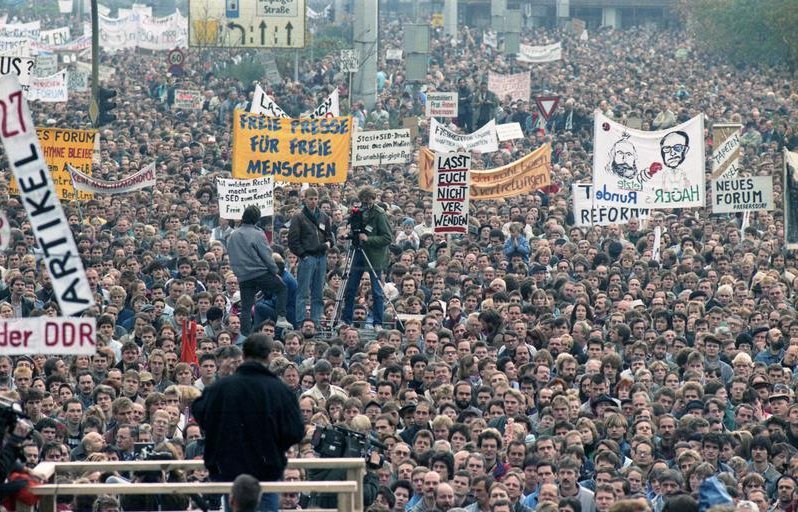
The Alexanderplatz demonstration in East Berlin on November 4, 1989. Photo from Wikimedia Commons
This essay compares the perspectives Hannah Arendt and Anselm Jappe – two different thinkers, to be sure – on the relationship between modernity, reaction, and revolutionary transformation. Despite their substantial differences in focus and perspective, in both Arendt and Jappe’s analyses, modernity is not only contradictory, but something which produces contradictions itself. Modernity seems, paradoxically, both to actualize and undermine the conditions for progress in terms of freedom and equality, and to therefore point beyond the existing crisis-ridden order to something different and unknown.
What modernity?
‘Modernity’ has many associations, including urbanization, secularization, individualism, capitalism, industrialization, political freedom and equality, the sovereign nation-state and the welfare state, the undermining of tradition, and the promise of social, scientific, and technological progress. Marshall Berman argues that modernity can be understood in terms of a ‘paradoxical unity’:
To be modern is to find ourselves in an environment that promises us adventure, power, joy, growth, transformation of ourselves and the world and, at the same time, that threatens to destroy everything we have, everything we know, everything we are. Modern environments and experiences cut across all boundaries of geography and ethnicity, of class and nationality, of religion and ideology: in this sense, modernity can be said to unite all mankind. But it is a paradoxical unity, a unity of disunity: it pours us all into a maelstrom of perpetual disintegration and renewal, of struggle and contradiction, of ambiguity and anguish. To be modern is to be part of a universe in which, as Marx said, ‘all that is solid melts into air.’3
This paradoxical unity did not appear suddenly. It developed disjointedly and unevenly over a long period. Berman captures this by distinguishing between three phases of modernization. The first stretched from the sixteenth to the eighteenth century. During this period, the concept of sovereign nation-states was established in political thought through, for example, Machiavelli and Hobbes. These ideas resonated well with emergent capitalism and the need for revolutionized legal and political orders. The transition into modernity was sluggish and developed outside the minds of those who lived through it, who could not realize the magnitude of the change.
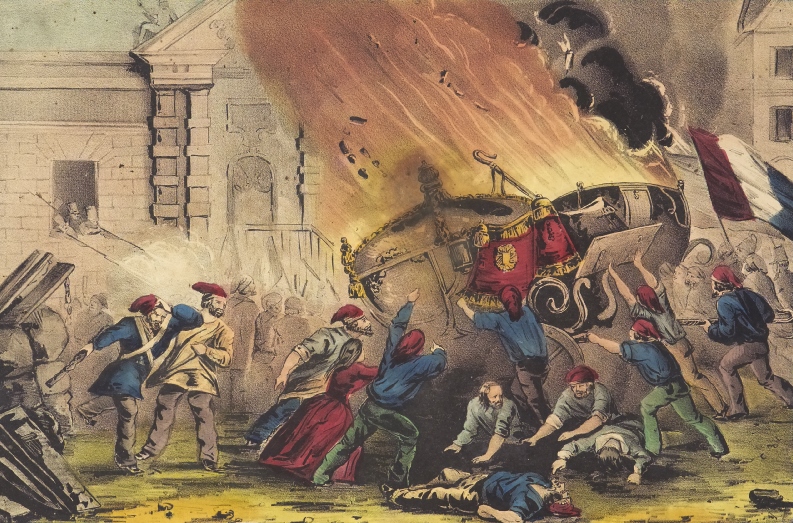
The royal carriage of king Louis Philippe is burned in front of the Chateau d’eau during the French revolution of 1848, Paris 24th February 1848
Photo from Wikimedia Commons
This was abruptly altered by the second phase, ignited by the American and French Revolutions. These world-historical events brought with them a modern public sphere that not only broke with the existing order but established a new structure. This became the framework for political developments up until the present. In this sense, modernity constitutes a logic of expansion and subsumption of ever new areas.
During the twentieth century, modernization entered its third phase, where the ‘modern’, thorough colonialism, imperialism, national liberation, and innovations in communication technology, now reaches across the globe.
From this perspective, revolution is central for understanding modernization. It was not until the fundamental upheavals at the end of the eighteenth century that modernity went from being a tendency to constituting a social form. If we follow political theorist Hannah Arendt, however, the opposite is also true. Any attempt to understand revolution must, Arendt thinks, begin with the insight that revolution is a specifically modern phenomenon.
Revolution is modern
In On Revolution, Arendt tries to understand the modernity-revolution relationship by remembering and reviving what she calls the ‘lost treasure of revolution’. The idea that revolution is, as Arendt puts it, ‘specifically modern’ might sound strange, given the long history of revolts and civil wars. Arendt claims, however, that ‘revolution’ takes on a new meaning in modernity. If we were to talk about revolution in general, equating pre-modern revolts with their modern forms, we risk neglecting the uniqueness of modern revolutions.
It is not until the modern age that the preconditions are in place for revolutions to be a ‘new beginning’. Originally, revolution was an astronomical term indicating a recurring, cyclical movement, a ‘lawfully revolving motion’, an ‘irresistable force’ and a ‘swinging back into a preordained order’.4 In this sense, revolution means going back to a previous stage.
The modern idea of ‘new beginnings’ was born of a new norm: modern thinkers hold that human beings have universal rights, but they have not yet been realized. This implies an order based on public freedom, a political arena where all people can participate as political subjects. In The Human Condition, Arendt argues that freedom, and what she calls ‘action’, are only possible in a public sphere strictly distinguished from the private (and economic) sphere. Ancient Athens laid the basis for this with the agora, the public marketplace in which all free men could act politically. It is not until modernity, however, that this promise can be realized in practice. The problem, for Arendt, is that modern revolutions have repeatedly failed to do this. The perversion of revolutions’ original promise, in which they are turned into their own opposites, even seems predetermined.
Arendt analyses historical revolutions, especially in France and the United States. She argues that these revolutionary projects confronted modern social logics that counteracted revolutionary change, but in different ways. A central condition is what, in The Human Condition, Arendt calls ‘the social’. This is the sphere where the boundaries between public and private are blurred, which undermines the conditions for a distinct political public sphere. In On Revolution, Arendt states that
the reality which corresponds to this modern imagery is what, since the eighteenth century, we have come to call the social question and what we may better and more simply call the existence of poverty. Poverty is more than deprivation, it is a state of constant want and acute misery whose ignominy consists in its dehumanizing force; poverty is abject because it puts men under the absolute dictate of their bodies, that is, under the absolute dictate of necessity as all men know it from their most intimate experience and outside all speculation.5
The problem for Arendt is that the poverty inherent in modern societies, where a major part of the citizens must de facto sell their labour. This perverts the struggle for freedom into the struggle for liberation, which undermines revolution in two ways.
First, liberation demands a particularly destructive form of representation. The poor masses live under such miserable conditions that they cannot directly participate in political action. When the central aim of political actors was to liberate these masses, Arendt writes, ‘the men of the revolution and the people whom they represented were no longer united by objective bonds in a common cause’6 by establishing a new political body.
Second, liberation implies that the private sphere colonizes the public sphere. Arendt argues throughout The Human Condition that the public realm of the ancient polis was distinct from the private realm of the household. The agora was an arena of freedom occupied by citizens equal in status but distinct as individuals. In ancient Greece, this realm was not only experienced as agonistic. It was also free from relationships between rulers and ruled, because these arrangements belong to the private realm of necessity, excluding women, slaves, barbarians, and others.
For Arendt, the centrality of the ‘social’ in modernity perverts politics by allowing private concerns to dominate. In the struggle against poverty, people gather based on their common interests rather than debating issues and making decisions based on their differences as individual political subjects. Liberation thus means that politics is dominated by striving for a higher ideal: the happiness of the many. In the French and the Russian revolutions, this meant that freedom, citizens’ direct participation in the public sphere, was ‘surrendered to necessity.’7
Revolutions can also be undermined by what has been called the ‘rights paradox’.8 As Hauke Brunkhorst shows, what we call modernity, given the norm of universal rights, is among other things a series of legal revolutions where specific concepts of rights and obligations were established, resisted, renegotiated and, challenged.9
In On Revolution, Arendt argues that ‘the trouble with these rights has always been that they could not be less than the rights of nationals, and that they were invoked only as a last resort by those who had lost their normal rights as citizens.’10 This is mainly because the modern political order is founded on the sovereign nation-state. Since the state-form is territorially demarcated, it guarantees and enforces rights for citizens alone and nobody else, leaving the stateless deprived of rights or, in the words of Giorgio Agamben, ‘bare life’.11 This means that, within the confines of the nation-state, revolutions have shifted from republican universalism to nationalist particularism.12
Finally, the relationship between revolution and modernity is structured by what Arendt identifies as the Hegelian ‘modern concept of history’. Arendt claims that, ‘theoretically, the most far-reaching consequence of the French Revolution was the birth of the modern concept of history in Hegel’s philosophy.’13 She continues:
Hegel’s truly revolutionary idea was that the old absolute of the philosophers revealed itself in the realm of human affairs, that is, in precisely that domain of human experiences which the philosophers unanimously had ruled out as the source or birthplace of absolute standards. But if this side of Hegel’s modern concept of history was revolutionary, its view of the relationship between actor and history is contradictive to revolution.14
Arendt argues that this turns history into an abstract ‘irresistable force’ while reducing individuals to spectators of the theatre of historical development. In a comment on the October Revolution, she says the revolutionaries obeyed no one but ‘historical necessity’:
There is some grandiose ludicrousness in the spectacle of these men– who had dared to defy all powers that be and to challenge all authorities on earth, whose courage was beyond the shadow of a doubt– submitting, often from one day to the other, humbly and without so much as a cry of outrage, to the call of historical necessity, no matter how foolish and incongruous the outward appearance of this necessity must have appeared to them. They were fooled, not because the words of Danton and Vergniaud, of Robespierre and Saint-Just, and of all the others still rang in their ears; they were fooled by history, and they have become the fools of history.15
For Arendt, this view of history suppresses action, the most specific feature of modern revolutions, because this amounts to the free act of beginning something new.
Arendt’s analysis of the rise of the social, the rights paradox, and the modern concept of history is ultimately about showing how the logics of modernity tend to threaten and pervert revolution as a ‘new beginning’. She also wants to reappropriate the past and, by discovering the lost treasure of revolution, encourage modern people to develop the courage to think about, and act to found and sustain, spaces of freedom. The eclipse of tradition, religion, and authority in modernity opens, for Arendt, a ‘gap between past and future’ where thinking and action can take place. This promise can be realised if and only if a revolution overcomes the conditions that turn revolution into something else.
On Revolution, like all of Arendt’s works, has been interpreted in many contradictory ways.16 Perhaps the most recurrent criticism is directed at her ‘idealized politics’.17 Even though Arendt argues that revolution is specifically modern, she analyzes it using concepts detached from any historical context. A recurring critique from Hegelian, Marxist, and feminist theorists is that Arendt historicizes her concepts inconsistently.18This is particularly evident in her lack of interest in capitalism or Karl Marx’s critique of classical political economy.
Revolution without a Subject?
If Arendt is not interested in these issues, it is absolutely central to the ‘critique of value’ tradition. One fundamental idea of Marx, and many of his followers, concerns the proletariat as a ‘revolutionary subject’. The demise of capitalism is assumed to go together with the organizing of a ‘class-conscious’ proletariat that will overthrow capitalism and move towards a classless society.
Thinkers from the ‘critique of value’ tradition tend to reject this idea. In this hybrid between the critical theory of the Frankfurt School and the Marxian critique of political economy, it is not the working class but capital that is the grave-digger of capitalism. The intrinsic problem in capitalism, for this line of thought, is that the system is characterized by a central contradiction.
Value is created through the exploitation of labour, but individual capitalists compete with each other by replacing relatively expensive (human) ‘living labour’ with cheaper ‘dead labour’ (machinery). Capitalism has, throughout history, temporarily overcome this paradox by expanding, opening new markets, and increasing the volume of goods produced and sold. Central to the critique of value tradition, however, is the idea that the microelectronic revolution of the 1970s, when robots, computers, measurement instruments, and other electronic devices were brought into the production process, created a qualitatively new situation. Automation and robotization abolish work at an unprecedented speed, but neither new work tasks nor professions are created at the same rate.19This undermines the ‘substance of value’.
This perspective has some important implications for thinking about the transition from modernity and capitalism to something else. In the essay ‘Être libres pour la libération?’, Anselm Jappe argues that the current demise of capitalism does not run parallel with the emergence of a revolutionary subject mature enough to reorganize society into a new social form.20
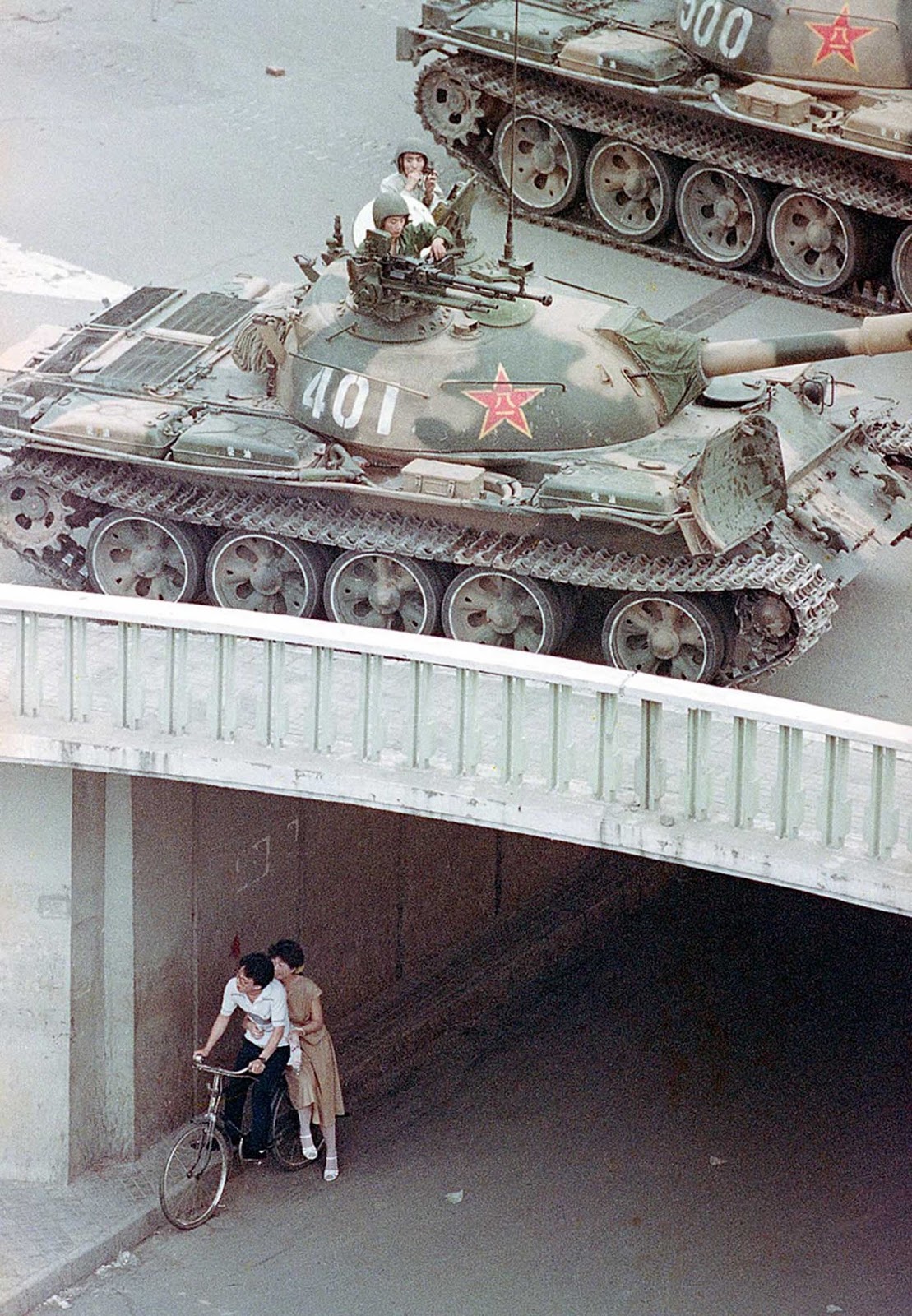
Chinese troops crushed a pro-democracy demonstration held by students and other demanding democratic reform in Tiananmen Square on June 4.
Photo via CND
The current protracted crisis is not, for Jappe, merely a slow demise of an economic system that has reached the limits for its own expansion. It is also a crisis for the two dominant anti-capitalist strategies of the twentieth century.
The first can be called ‘state-governed centralization’. This ‘real socialism’, according to Jappe, was never anti-capitalist. It was, rather, a state-capitalist strategy to expedite economic modernization. The second strategy was about embracing the positive effects of technological development. The basic idea was that increases in productivity would produce affluence and that new technology would end alienating labour.
For Jappe, capitalism today is characterized not by the exploitation of labour, but the mass production of, as Marx put it, a relative ‘surplus population.’21 While wage-labour persists as the dominating norm, there are not enough jobs to keep unemployment down. In earlier revolutions, the anti-capitalist force came from groups who experienced capital as an invasion from outside. The artisans and small farmers who, through their relative control of the means of production, stood in a ‘complacent servile relationship’ to their work resisted the new forms of labour that capital enforced on them.22
Capitalism has expanded since then, gradually subsuming non-capitalist life-activities. When new technology abolishes work at an accelerating rate, a growing number of people are excluded from the labour market. In a historical situation where capital pervades social life, it is primarily the fear of being excluded from capitalist ways of life that guides human action. This is, according to Jappe, something very different from the enragement that pre-capitalist artisans experienced when capital stripped them of professional freedom and pride. Jappe would probably see the ‘Yellow Vests’ movement, with its motley composition of groups and demands, as a perfect illustration of a movement primarily driven by a fear and frustration of being left behind in the neoliberal era.
This present culture of fear produces two responses. People are either desperate to regain a place in the comforting arms of the labour market, or to make a living from gambling, drugs, or prostitution, rather than acting to overthrow the system itself. Such a situation, according to Jappe, calls for a double critique.
First of all, critical theory needs to demonstrate that capitalism cannot create the miracles its adherents hope for. Secondly, it needs to demonstrate the limits to protest and dominant political strategies. Re-regulation of financial markets, or a more progressive redistribution of resources, will not save capitalism from itself. Nor can it offer safety nets to all those who suffer from the consequences of its demise. Instead, the hope lies in ‘engaging in the enterprise of collectively creating a better way to live in the ruins that capitalism will leave behind’.23
Revolution as accelerated modernity
A common theme for both Arendt and Jappe is that modern society is constituted by internal contradictions pointing beyond the existing order to something unforeseeable. We can, then, argue that their respective analyses treat different sides of what we can call revolution as accelerated modernity.
Michael Makropoulos has described modernity as an ‘ontological state of emergency’.24 This was particularly evident in Weimar Germany. The overthrowal of the emperor, the humiliating and economically catastrophic Treaty of Versailles, and the crushing of the attempted communist revolution, created a nervous, volatile political situation within the new republic. Institutions, norms, and values that had been taken for granted suddenly seemed hopelessly obsolete as points of orientation.
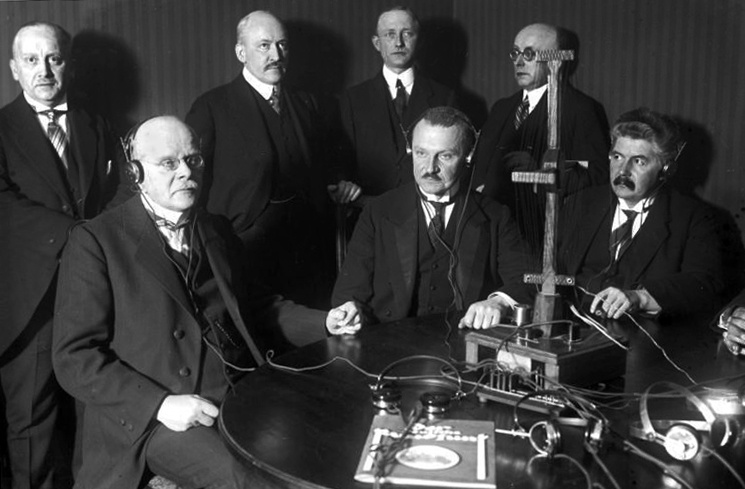
Radio address by Chancellor Dr. Wilhelm Marx.- Sitting, from left to right: Wilhelm Marx, Ernst Wilhelm Scholz and Paul Fleischer
Photo from Wikimedia Commons
A new historical-social space came into existence as a result. Here, groups with radically opposed world-views encountered each other in a battle over what had been, what was, and what could be. Germany seemed to be caught up in an unstable balancing act between radically-opposed future scenarios. As Carl-Göran Heidegren states, however, this ontological state of emergency was not a break with modernity.
A defining characteristic of modernity is, he says, an ‘increased experience of contingency.’ Nothing about ‘new normal’ can be taken for granted as traditions, values, and norms are dissolved. From this perspective, the ontological state of emergency during the crisis-ridden years of the Weimar Republic should rather be understood as a situation in which the Germans took an ‘abrupt step straight into the modern condition.’25
Neither Arendt nor Jappe uses the term ‘ontological state of emergency’. Nevertheless, there are good reasons to apply it to revolutionary situations in general. Arendt states that the revolution is, paradoxically, both a promise of a new beginning and deeply rooted in the modern. Here, we can return to Charles Baudelaire, who stated that modernity is ‘the transient, the fleeting, the contingent; it is one half (of art), the other being the – eternal and the immovable’.26
In a revolutionary situation, things that once appeared eternal and immovable, as ‘second nature’, appear to be unrealistic and obsolete. In this sense, revolution is an accelerated expression of the modern general condition that Walter Benjamin describes as ‘the increasing atrophy of experience’.27
When total change and revolution become normal, the present becomes merely temporary and unstable. The future is, consequently, not a prolongation of the present, but something open and potentially radically different. When tomorrow is uncertain, former experiences and forms of wisdom lose their authority as the self-evident point of orientation for how we should think and act.
For Arendt, revolution becomes possible through the modern separation of thinking and action from all that is eternal and immovable about tradition, destiny, God, and history.28 From this point of view, revolution can be understood as an acceleration of the contradiction between the transient and the eternal. When establishing a new political order, people try to break free from the chains of history and establish lasting freedom.
The logic is, however, the opposite for Jappe. The internal contradictions of capitalism appear to him as a seemingly eternal force, a second nature imposing its logic on the world which, at the same time, undermines itself. This has implications for understanding how human action can transcend modernity and capitalism. The self-destruction of the system opens a multitude of contradictory strategies.
One way of reacting to the systemic crisis is, according to Jappe, the enraged struggle to avoid becoming part of the relative surplus population. Another way is to be comforted by a reactionary longing for the return of an idealized stable and harmonious original state. Another alternative is, following the futurists, to embrace contingency: to maintain and even accelerate it. Thus, fighting for a radical transformation of social structures towards more freedom, equality, and democracy is only one of many different tendencies in a revolutionary situation.
In other words, the paradoxical unity that is, for Berman, constitutive of modernity is accelerated in a revolutionary situation. This explains today’s chaotic and confusing co-existence of doomsters and ‘Messiah’ figures, conspiracy theories and the scientistic worship of ‘evidence’, mass actions of solidarity with migrants and arson attacks against refugee camps, climate change denial, prepping, and so on.
It might be argued that Arendt and Jappe occupy different places on the spectrum between voluntarism and determinism. They certainly both interpret the potential for the transformative rise of a revolutionary subject in different ways. Such a claim would, however, neglect the nuances in these writers’ thinking about social transformation.
Arendt, like Jappe, views revolutionary situations as open and undecided conflicts between contradictory tendencies. It is impossible to know their outcome because they are decided as they happen. Another shared theme is that the chances of influencing the outcome are at least partially dependent on achieving a self-reflexive distance from modernity. There is something vital at stake in the battle over contesting truth-claims and strategies in an ontological state of emergency. It is the productive understanding of the relationship between the past, present, and future, and how we can act based on what we learn.
For Arendt, revolution is a radical break with tradition, a qualitative transition to something new. For this to be possible, however, it must be grounded in remembrance of the past while still being anchored in the present. By turning to the agora of ancient Greece, Arendt tried to show how political freedoms once reserved for men and excluded women, slaves and ‘barbarians’ becomes, in modernity, something universal. The past is used to lay bare limitations, anomalies, and potentials in the present.
Conversely, the present is used as a vantage point for a critique of the past by demonstrating that present conditions can allow us to break with the limitations, wrongs, and atrocities of past social forms. Taken together, this points towards a future order beyond the past and present; it emerges from existing conditions but establishes a new beginning so different and uncertain that it is hard to even imagine what it can mean.
In Jappe’s case, we are dealing with a critique of what Michael Heinrich calls ‘worldview Marxism’. Jappe claims that revolutionary movements internalize underlying ideas about modern capitalist ideology even if they present themselves as alternatives. Worldview Marxism is a kind of ‘pop-Marxism’ established at the same time as the labour movement. This movement needed a worldview to give it historical legitimacy and a ‘cause’. The narrative that was established, in some countries institutionalized as a state ideology, was permeated with the era’s widely held ideologies. Heinrich sums these up as ‘crude economism(ideology and politics reduced to a direct and conscious transmission of economic interests) as well as a pronounced historical determinism that viewed the end of capitalism and the proletarian revolution as inevitable occurrences.’29
From Jappe’s position, worldview Marxism appears to be, pace Nietzsche, modern, all too modern. This is evident in the Marxist-Leninist embrace of industrialization and Fordist forms of work-organization in the Soviet Union. Another line of reasoning within worldview Marxism that, by organizing as a class, the workers will develop from a class ‘in itself’ into a class ‘for itself’ and become the revolutionary subject that will overthrow capitalism. This idea is perfectly in line with the modernist idea of ‘progress’. It is also in line with modern ‘rational choice’ thinking. By calculating their class interests, individual actors are transformed into a kind of collective rational actor that puts an end to class society based on its shared interests.
Jappe’s analysis has other implications. Maybe the transformation from modernity to something new will develop as unevenly and spasmodically as the emergence of modernity itself. Perhaps what comes after modernity is not one but a variety of different systems. Perhaps revolution is not an ‘event’ with temporal and spatial demarcations, but something that develops in different ways at different speeds in different places. Taken together, Arendt and Jappe, with their different ideas about which logics, forces, and contradictions of modernity point beyond the existing order, offer a rich set of tools for thinking about what revolution has been, what it is today, and what it might become in the future.
Charles Dickens (1859), A Tale of Two Cities
Eric Hobsbawm (1994), Age of Extremes: The Short Twentieth Century, 1914-1991
Marshall Berman (1982), All that is Solid Melts into Air: The Experience of Modernity
Hannah Arendt (1963), On Revolution
ibid., p. 54
ibid., p. 69
ibid. p. 60
Costas Douzinas (2007). Human Rights and Empire: The Political Philosophy of Cosmopolitanism.
Hauke Brunkhorst (2014), Critical Theory of Legal Revolutions: Evolutionary Perspectives.
Arendt, 1963, p. 169
Giorgio Agamben (1995), Homo Sacer: Sovereign Power and Bare Life.
Fine, R. (2005), ”Kant’s Cosmopolitan Ideal and Hegel’s Critique”, in Fine, R., Political Investigations: Hegel, Marx and Arendt, p. 137
Arendt, 1963, p. 45.
ibid.
ibid. p. 58.
The academic journal European Journal of Cultural and Political Sociology recently published a special issue about On Revolution. See , “Introduction”, in European Journal of Cultural and Political Sociology, volume 1, 3 (2015), pp. 213–215.
Gillian Rose (1992), The Broken Middle: Out of Our Ancient Society, p. 223.
E.g. Robert Fine, Political Investigations: Hegel, Marx, Arendt(2001); Bonnie Honig (2013). “Toward an Agonistic Feminism: Hannah Arendt and the Politics of Identity”, in Feminists Theorize the Political (pp. 233-254). Routledge; Hanna Fenichel Pitkin, The Attack of the Blob: Hannah Arendt’s Concept of the Social(1998). The literature on the critique of value is predominantly in German. For an overview of key texts in English, see Neil Larsen, Mathias Nilges, Josh Robinson and Nicholas Brown (eds.), Marxism and the Critique of Value(2014).
For a popular discussion on this topic, see Paul Mason (2015), Postcapitalism: A Guide to our Future.
Anselm Jappe (2012), 'Être libres pour la libération?', Réfractions, 28, pp. 95
Karl Marx (1976), Capital, vol. 1, pp. 531-532.
Karl Marx & Friedrich Engels (1998 [1845–1846]), The German Ideology, p. 74.
Jappe (2012).
Makropoulos, M. (1989). Modernität als Ontologischer Ausnahmezustand? Walter Benjamins Theorie der Moderne.
Carl-Göran Heidegren, Preussiska anarkister: Ernst Jünger och hans krets under Weimar-republikens krisår(2016),p. 15.
Charles Baudelaire, “The Painter of Modern Life”, in Baudelaire, the Painter of Modern Life and Other Essays(1964 [1864]).
Walter Benjamin, “On Some Motifs of Baudelaire”, in Benjamin, The Writer of Modern Life: Essays on Baudelaire(2006 [1939]), p. 174.
Arendt, On Revolution(1963), p. 51; cf. Håkan Thörn, Rörelser i det moderna: Politik, modernitet och kollektiv identitet i Europa 1789–1989(1997), p. 69.
Michael Heinrich (2004), Introduction to the Three Volumes of Karl Marx’s Capital, pp. 24–25.
Published 1 August 2019
Original in Swedish
First published by Fronesis 60/61
Contributed by Fronesis © Hannah Ohlén Järvinen / Johan Örestig / Eurozine
PDF/PRINTSubscribe to know what’s worth thinking about.

On the space to the left of European social democracy: Eurocommunism’s continuing legacy; reflections on the rise and fall of Eurocommunism in the UK; and everyday communism in the Austrian city of Graz.
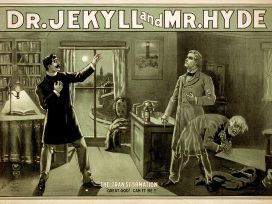
Voicing opinions to explain political tensions from afar is contentious for those treated as mute subjects. Focusing solely on distant, global decision-making disguises local complexity. Acknowledging the perspectives of East Europeans on Russian aggression and NATO membership helps liberate the oppressed and open up the debate.